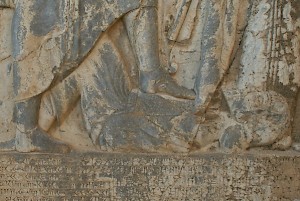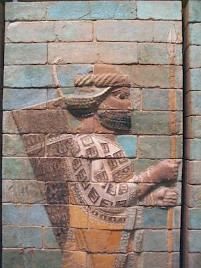Herodotus, bk 3, logos 8
Herodotus of Halicarnassus (c.480-c.429 BCE): Greek researcher, often called the world's first historian. In The Histories, he describes the expansion of the Achaemenid Empire under its kings Cyrus the Great, Cambyses, and Darius I the Great, culminating in Xerxes' expedition to Greece (480 BCE), which met with disaster in the naval engagement at Salamis and the battles at Plataea and Mycale. Herodotus' book also contains ethnographic descriptions of the peoples that the Persians have conquered, fairy tales, gossip, and legends.
The Coups of the Magians and Darius (3.61-119, 3.126-141, 3.150-160)

Note: the eighth and ninth logoi are both divided in two pieces, which are grouped like ABAB.
In the eighth logos, Herodotus tells his most romantic story: the coup d'état of the Magians in March 522. (The Magians were a Median tribe, considered specialists in religious rituals.) One of the Magians looks very much like the murdered prince Smerdis; his name also happens to be Smerdis. This pseudo-Smerdis proclaims himself king; his brother Patizeithes is the mastermind behind the plan. The two manage to gain support from Persia's subjects by a promise to acquit them of their taxes for three years.
When Cambyses hears from it, he rushes back to Persia, but when he springs into the saddle of his horse, the cap falls of the sheath of his sword and exposes the blade, which pierces his thigh. Herodotus does not fail to stress that this was just the spot where Cambyses had wounded the Apis (see above). Soon, the Persian king dies from gangrene.

The Persian elite cannot appreciate pseudo-Smerdis' policy towards the subject peoples, and seven conspirators assemble. Herodotus gives their names as Otanes (a son of the secret agent Prexaspes), Gobryas, Intaphrenes, Hydarnes, Megabyzus, Darius and Aspathines. Before they can strike, Cambyses' secret agent Prexaspes commits suicide, after announcing to the people of Susa (one of the capitals of the Achaemenid Empire) the truth about king Smerdis. The population of the city is restless. This is the moment the seven have been waiting for, and they kill the two Magians. Next, there is a debate about the future constitution of the Achaemenid empire. The seven decide that Persia has to stay a monarchy, and choose Darius as their king.
The new king divides the country into twenty satrapies (districts); Herodotus knows all their names and what kind of tribute they have to pay to the great king. The Indian satrapy gives Herodotus an opportunity to describe this country, including the gold-digging ants he believes to live there. There is a very entertaining digression on the edges of the earth (text).

Herodotus also informs us about the fall of Intaphrenes, one of the seven conspirators, and tells us about the Persian recapture of the rebellious city of Babylon. Zopyrus, son of the conspirator Megabyzus, cuts off his own ears and nose, and defects to the beleaguered city, saying that he was punished by Darius and that he wants to help the Babylonians. These entrust their army to him, but he opens the gates and lets the Persians in.
Comment
The narrative about this double coup does not sound very convincing, but we can corroborate Herodotus' story, because the same story is told in Darius' Behistun inscription. The main difference is that in Darius' story there is only one Magian, named Gaumâta, who seizes power and has himself called Bardiya (sections 10-15). Herodotus' duplication must be due to a misunderstanding of this man's title: Patizeithes is the Greek form of patikhšayathya or 'governor'. Probably, he heard about the patikhšayathya who called himself Bardiya, and erroneously thought that there were two men involved.
From the inscription, we know that Bardiya/Smerdis seized power on March 11, 522 BCE, that Cambyses died in July in Syria, hurrying home to suppress the rebellion, that there was a conspiracy of seven noblemen, who killed the false king on September 29. A point of some interest is the resemblance of the names of the conspirators, who are mentioned in section 68 of the Behistun inscription.
|
|
|
|
|
|
|
|
|
|
|
|
|
|
|
|
|
|
|
|
|
|
|
|
This means that Herodotus has only one name wrong: instead of Ardumaniš he mentions Aspathines. We may assume that the mistake was made by Herodotus' Persian spokesman: Aspaçânâ was a very important courtier.
The list of satrapies closely resembles comparable documents from ancient Persia, the Empire lists (e.g., section 6 of the Behistun inscription, the inscription on Darius' grave and the Daiva inscription by Xerxes - go here for a comparison of these texts). There are some minor inconsistencies, however, which cannot be explained.
The story about Zopyrus ending the revolt of Babylon is unlikely to be true in its present form, although comparison with section 32 of the Behistun inscription makes it clear that this type of mutilation was not uncommon. Probably, the story is inspired by Homer's description of Odysseus, who was able to spy in Troy after mutilating himself.note No Zopyrus is known from Babylonian cuneiform texts.
The Behistun inscription also informs us about two rebellions in Babylon, one under Nidintu-Bêl, who assumed the throne name Nebuchadnezzar, and one under the Armenian Arakha, who assumed the same name. The first of these two rebels revolted on 3 October 522 and was captured by Darius on 18 December; the second rebel ruled from 25 August 521 until 27 November and was defeated by Hydarnes, one of the seven conspirators. In the same period, there were two rebellions in Elam, one in Sagartia, one in Margiana, one in Persia, and one in Media (mentioned briefly by Herodotus, who does not mention that Darius' father Hystaspes was one of the Persian commanders in this theater of operations).